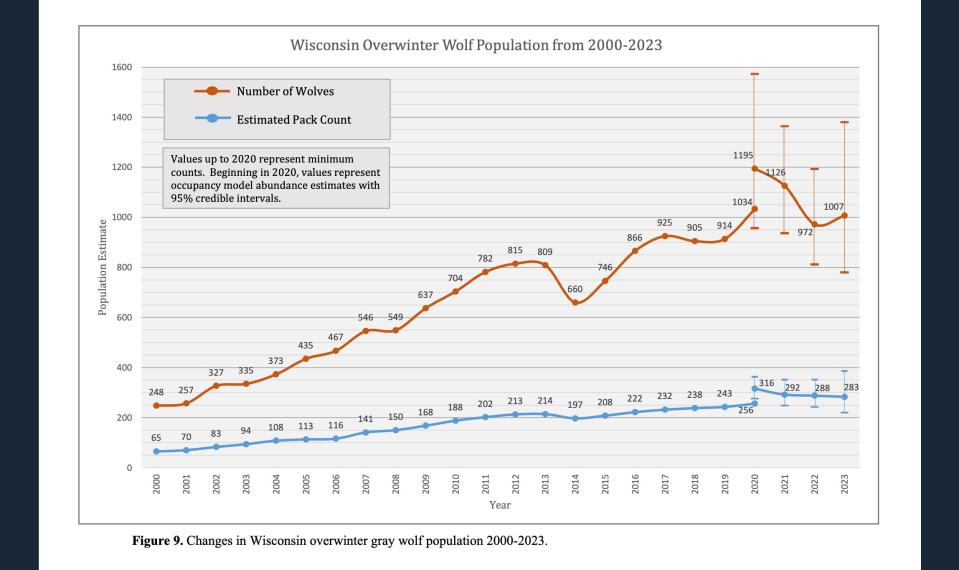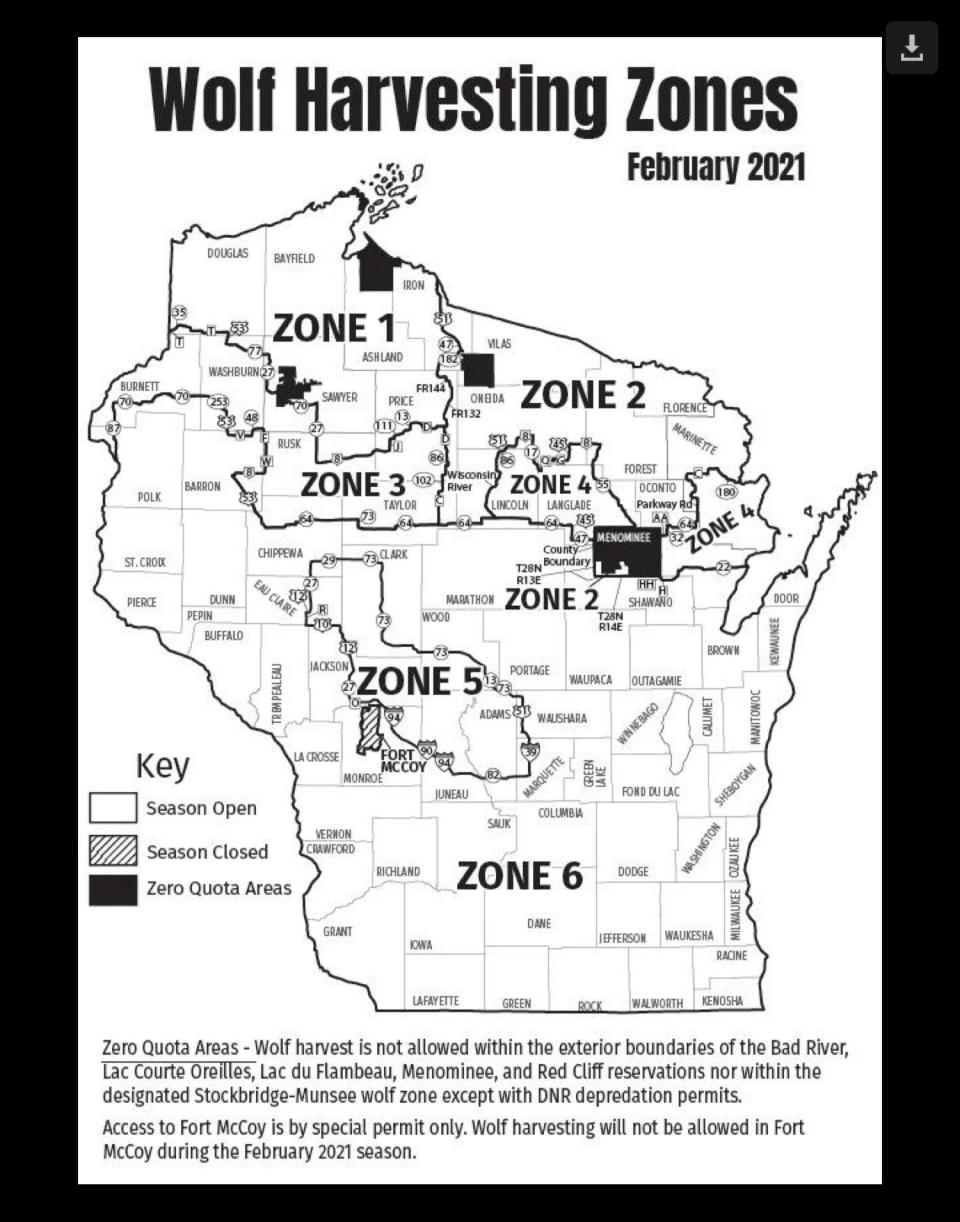After years of work, Wisconsin finally has an updated wolf management plan
For the first time since 1999 and after nearly three years of work by the Department of Natural Resources, Wisconsin has a new gray wolf management plan.
The Natural Resources Board on Wednesday approved the document, designed to cover wolf management in the state over the next decade. The vote was unanimous among the seven-member citizen board.
The plan replaces one approved in 1999 and reaffirmed with an addendum in 2007. Since that time, the biological, scientific, social and legal contexts surrounding gray wolf conservation and management in the state have changed dramatically, according to the DNR.
Randy Johnson, DNR large carnivore specialist who led the department team that wrote the plan, has been using a slogan of "from recovery to sustainable management" to describe wolves in Wisconsin.
More: Smith: Wolves are a keystone species in nature but at center of a political divide
Wolves are native to Wisconsin but were extirpated in the 1960s and increased in number beginning in the 1970s due in part to protections of the federal Endangered Species Act.
The latest DNR report estimated 1,007 wolves in 283 packs in Wisconsin in late winter 2023.
New Wisconsin DNR wolf management plan provides a framework for years to come
Johnson said the new wolf plan explicitly recognizes the species has recovered in the state and provides a practical vision for wolf management and stewardship for the coming years.
"If fully implemented this plan would support the perpetuation of a healthy wolf population in Wisconsin to fulfill it's numerous roles and benefits, while also being responsive in effectively addressing wolf-related conflicts and concerns," Johnson said.
The plan has six objectives: ensure a healthy and sustainable wolf population to fulfill its ecological roles; address and reduce wolf-related conflict; provide multiple benefits associated with the wolf population; increase public understanding of wolves in Wisconsin; conduct scientific research to inform wolf stewardship; and provide leadership in collaborative and science-based wolf management in Wisconsin.
The DNR has been working to update its wolf plan off-and-on for more than a decade. A proposed update languished under several administrations but got a significant push under Gov. Tony Evers and previous DNR Secretary Preston Cole.
Under Cole, the DNR formed a wolf management plan committee and conducted a social science survey on public attitudes toward wolves.
After Cole retired in 2022, the wolf plan work continued under newly-appointed DNR Secretary Adam Payne.
Wisconsin would likely continue to have a wolf population of 800-1,200
The DNR released its draft plan Nov. 10 and accepted public input on it through Feb. 28. The department received about 3,500 public comments.
It then released an updated draft plan Aug. 1 with several modifications, including a table that showed the plan would likely result in a wolf population range of 800 to 1,200 wolves, or about the same number the state has had over the last decade.
Johnson said the plan recognizes growing public support for gray wolves and calls for sustainable, long-term management and stewardship of the animals in the state.

Of note, the plan approved Wednesday does not have a statewide numerical population goal and instead focuses on "adaptive" management objectives established in six wolf zones and seven subzones.
The 1999 Wisconsin wolf management plan included a population goal of 350 wolves, a number groups such as the Wisconsin Wildlife Federation, Wisconsin Bear Hunters Association and Wisconsin Cattlemen's Association had urged the DNR to include in the updated document.
However over the last two decades biologists have learned wolves can inhabit more of the state and exist at higher numbers than previously thought.
Surveys show support for wolves among Wisconsin residents
Social science surveys conducted by the DNR in 2014 and 2022 showed strong public support for wolves in Wisconsin. In the 2022 work, Wisconsinites somewhat or strongly agreed that predators like wolves keep nature in balance (77%), wolves are culturally important (71%), and wolves are special animals that deserve our admiration (75%).
Similarly, a majority of Wisconsinites agreed that people and wolves should be able to coexist (75%) and that it is important to maintain a wolf population in Wisconsin (80%).
The survey also asked if people wanted more, the same or fewer wolves than are currently found in the state.
When broken down for responses from residents in wolf range, 55% preferred the same number or more wolves, while 27% fewer or many fewer, 7% zero and 12% "I don't know." For those outside wolf range, 68% preferred the same or more, 12% fewer or many fewer, 3% zero and 18% "I don't know."
When compared to 2014 data, the level of support for the same or more wolves increased slightly in the 2022 survey.
There also was good support for the current distribution of wolves. The most common response among both wolf-range residents (41%) and those residing outside of wolf range (47%) was for wolves to occupy about the same amount of the state as their current geographic distribution.
On Wednesday the board took testimony on the wolf plan from about 50 people, including representatives of Native American tribes, conservation organizations and individuals. The comments varied from strong support to opposition, with many wolf advocates asking for stronger protections for the species than provided in the plan.
The Wisconsin Conservation Congress and Wisconsin Farm Bureau reiterated their opposition to the plan.
This wolf plan is designed to accommodate hunting and trapping as required
Fred Clark, executive director of Wisconsin's Green Fire, said his organization supported the updated plan in part because it would help show the state would be more responsible if and when the species was removed from protections of the federal Endangered Species Act.
"The old plan is no longer relevant," Clark said. "We have 24 years of new data and new experience. The only time we have all the management tools will be when wolves are delisted. This plan helps us get there."
The wolf management plan approved Wednesday aligns with the latest biological and social science regarding wolves in Wisconsin, according to the DNR.
When allowed by federal endangered species law and in-state legal status, it would also include a wolf hunting and trapping season as required by state law.
In many respects, the new wolf plan follows tenets established and widely supported in the Wisconsin black bear management plan. The bear plan also does not set a numerical statewide goal or limit on the species.
Public testimony and board discussion of the wolf plan covered five hours of Wednesday's meeting, one of the longest agenda items in many years.
The plan was approved unanimously with one amendment. It places a maximum harvest of two wolves on any subunit of wolf management zone 1B, which borders the Bad River tribal reservation near Ashland.

Vote goes on despite Wisconsin Senate's rejection of Gov. Tony Evers' resources board appointees
Wednesday's meeting was the first for four NRB members, appointed last week by Gov. Tony Evers after the Wisconsin Senate rejected four other appointees.
The Senate's action, which many believe was related to concerns over wolf management and an effort to prevent the board from having a quorum at Wednesday's meeting, was unprecedented. Only once in history (in 1999) had a Governor's appointee to the board been rejected by the full Senate.
The turmoil didn't prevent the DNR and NRB from proceeding with its legal roles, however.
Board member Paul Buhr, a farmer from Viroqua, said he understood the plan might not provide everything everybody wanted, but in the long run it was a good plan for farmers.
Johnson said the DNR was now looking toward the next phase of wolf management and what long-term wolf management will look like in Wisconsin.
He acknowledged the range of viewpoints regarding wolves as well as the challenges facing the department.
"The plan cannot answer all of our questions for us, it cannot tell us what the next wolf quota should be, it cannot tell us what the right number of wolves should be," Johnson said. "(But) it provides us with a framework for making effective and responsible decisions based on public input and science to help us with this next chapter."
With the new plan approved, Johnson said the DNR would continue to watch for changes in legal status that could return state management authority for the species, as well as coordinate the wolf tracking program over the coming winter and work to get more wolves in the state fitted with GPS-tracking collars.
This article originally appeared on Milwaukee Journal Sentinel: New Wisconsin wolf management plan approved by Natural Resources Board

